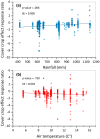When do cover crops reduce nitrate leaching? A global meta-analysis
- PMID: 35583665
- PMCID: PMC9328130
- DOI: 10.1111/gcb.16269
When do cover crops reduce nitrate leaching? A global meta-analysis
Abstract
The global increases in the surface and groundwater nitrate (NO3 - ) concentrations due to synthetic fertilizer input have emerged as major sustainability threats to terrestrial and aquatic ecosystems. Cover crops can reportedly reduce nitrate leaching from croplands. However, the underlying mechanisms and the effectiveness of cover crops in reducing nitrate leaching across species, soil types, agronomic management, and climates remain elusive. We conducted a global meta-analysis to evaluate the effects of cover crops on nitrate leaching and water drainage. A random-effects analysis was established to investigate seven moderating variables in 41 articles. Results showed that globally, cover crops reduced nitrate leaching by 69% compared with fallow while demonstrating no effect on water drainage. Overall, cover crops from Brassicaceae and Poaceae families showed the greatest effect with 75% and 52% reduction in nitrate leaching, respectively. Cover cropping on Ultisols, Histosols, and Inceptisols resulted in the greatest reduction in nitrate leaching (77%, 78%, and 77%, respectively). Greater efficacy of cover crops at reducing nitrate leaching was evident with increasing soil sand content. In general, cover crops appeared to perform better to reduce nitrate leaching in vegetable systems compared to field crops. Cover cropping on conventional tillage resulted in a 63% reduction in nitrate leaching compared with no-tillage (50%) and reduced tillage (38%) systems. The impact of cover crops on water drainage was nonsignificant which implies that nitrate leaching control by cover crops is unlikely exerted through reducing water drainage. This study brings further insight into the intrinsic factors affecting cover crop efficacy and management practices that enhance cover crop potential in reducing nitrate leaching from agricultural systems.
Keywords: brassica; cover crop; grass; legume; nitrate leaching; no-tillage; soil order; soil texture.
© 2022 The Authors. Global Change Biology published by John Wiley & Sons Ltd.
Conflict of interest statement
The authors declare no conflict of interest.
Figures








References
-
- Abdalla, M. , Hastings, A. , Cheng, K. , Yue, Q. , Chadwick, D. , Espenberg, M. , Truu, J. , Rees, R. M. , & Smith, P. (2019). A critical review of the impacts of cover crops on nitrogen leaching, net greenhouse gas balance and crop productivity. Global Change Biology, 25(8), 2530–2543. 10.1111/gcb.14644 - DOI - PMC - PubMed
-
- Al‐Kaisi, M. , & Licht, M. A. (2004). Effect of strip tillage on corn nitrogen uptake and residual soil nitrate accumulation compared with no‐tillage and chisel plow. Agronomy Journal, 96(4), 1164–1171.
-
- Alletto, L. , Benoit, P. , Justes, E. , & Coquet, Y. (2012). Tillage and fallow period management effects on the fate of the herbicide isoxaflutole in an irrigated continuous‐maize field. Agriculture, Ecosystems & Environment, 153, 40–49.
-
- Alshameri, A. , He, H. , Zhu, J. , Xi, Y. , Zhu, R. , Ma, L. , & Tao, Q. (2018). Adsorption of ammonium by different natural clay minerals: Characterization, kinetics and adsorption isotherms. Applied Clay Science, 159, 83–93.
-
- Aristarán, M. , Tigas, M. , & Merrill, J. B. (2018). Tabula technology: Knight foundation. Retrieved from https://tabula.technology/
Publication types
MeSH terms
Substances
LinkOut - more resources
Full Text Sources

